 |
Picks is a monthly sampling of Japan's art scene, offering commentary by a variety of reviewers about exhibitions at museums and galleries in recent weeks, with an emphasis on contemporary art by young artists. |
 |
 |
 |
2 November 2015 |
 |
| 1 | 2 | |
 |
|
 |
 |
|
|
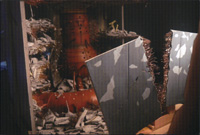 |
|
| Ryusuke Ito: All Things Considered |
| 22 August - 26 September 2015 |
Kodama Gallery
(Tokyo) |
 |
| Ito constructs miniature tableaux which he shoots with a CCD microcamera, simultaneously projecting the video image onto a nearby screen. Through his masterful manipulation of motion, angle, and simple materials like cotton and cardboard, he creates stunningly realistic illusions: a drone flying through clouds, people and things being sucked into the maw of a black hole, a melted-down nuclear reactor housed in a candy box. Ito's devotion to handmade craft, and his willingness to show viewers how he works his magic, make this installation both awe-inspiring and fun. |
|
|
 |
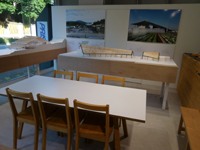 |
|
| SALHAUS: Shared Views |
| 21 August - 16 September 2015 |
Prismic Gallery
(Tokyo) |
 |
| Since forming SALHAUS in 2008, architects Motoki Yasuhara, Masashi Hino, and Mari Tochizawa have earned plaudits for projects that range from residential housing to repairing old inns to rebuilding a school in tsunami-struck Rikuzen-Takada. This special exhibition would seem to be a prime opportunity for the group to make a strong statement. Like any art show, however, it could use a good curator. |
|
|

|
 |
 |
 |
 |
| Manika Nagare: Rivers Need Springs |
| 5 September - 3 October 2015 |
Yuka Tsuruno Gallery
(Tokyo) |
 |
| Nagare's oils, both large and small, are displayed in scattershot fashion across the gallery walls. Superficially, her abstract style brings to mind Clyfford Still -- but if Styll's work was like a rock-hard mountain, Nagare's is softer, with a moist, translucent air about it. |
|
|
 |
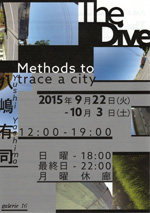 |
 |
| Yushi Yashima: The Dive - Methods to Trace a City |
|
22 September - 3 October 2015 |
Galerie 16
(Kyoto) |
 |
| Yashima filmed his video installation The Dive by strapping six small cameras to his body -- two on his head and one on each limb. The results are projected in full surround-mode onto the gallery's walls and floor. With images that sometimes overlap, sometimes envelop the visitor's own body, but never offer a unified omnidirectional view, the work willfully fragments as it progresses. It's a piece that poses challenging questions about our physicality and our systems of perception. |
|
|
|
|
|
|
|

|
 |
 |
|
 |
 |
| Daikanyama Photo Fair |
| 25 - 27 September 2015 |
Daikanyama Hillside Forum, other venues
(Tokyo) |
 |
| The Fine-Art Photography Association held its first photo fair last year in Tokyo's trendy Daikanyama district. This year it occupied the Daikanyama Hillside Forum and several other local sites. Participating were 20 of Japan's leading photography-oriented galleries, among them Emon Photo Gallery, G/P Gallery, MEM, Nap Gallery, and Taro Nasu. Offering a variety of relaxing ambiences in which to peruse images and books at leisure, as well as talks and workshops, the event amply conveyed the organizers' commitment to nurturing a comprehensive photo show over the long term. |
|

|
 |
 |
 |
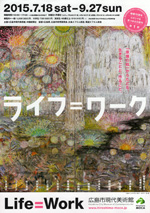
|
|
| Life = Work |
| 18 July - 27 September 2015 |
Hiroshima City Museum of Contemporary Art
(Hiroshima) |
 |
| The first of the museum's "Hiroshima Trilogy" of exhibitions on the 70th anniversary of the atomic bombing, this one begins with 50 "A-bomb drawings" by survivors, followed by a section on painters like Yasuo Kazuki and Shin Miyazaki whose work was informed by their brutal experiences in Siberian internment camps after the war. Next come Goro Shikoku, Tadashi Tonoshiki, and other artists confronting family tragedies associated with the bomb. Making their art from diaries and articles of clothing left behind by loved ones, these survivors engage in transmissions of memory that are also acts of mourning. |
|
|
 |
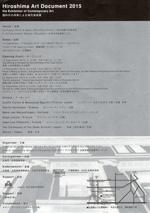 |
 |
Hiroshima Art Document 2015 |
19 September - 3 October 2015 |
Former Bank of Japan Hiroshima Branch
(Hiroshima) |
 |
| Independent curator Yukiko Ito has organized this international group show of contemporary artists every summer since 1994. This year's edition featured site-specific installations geared to the venue, a former bank and Hiroshima City-designated Important Cultural Property that survived the atomic bombing. Accompanying works by artists from the Netherlands and France were tea and flower offering ceremonies conducted by tea master Sokoryu Ueda and ikebana artist Shuho. |
|
|
|
|
|
|
 |
 |
| Miwako Iga: THAT'S NOT ENOUGH. |
| 1 September - 3 October 2015 |
Base Gallery
(Tokyo) |
 |
| Featured is Miwako Iga's photo series of soap operas staged with dolls. The behavior of the dolls is just a bit off: they seem to have been cruelly stuck in a moment of insufficient drama and narrative power, exposing their "slight lack of life." The title would suggest that this experiment in metamorphosis will continue to evolve for some time to come. |
|
 |
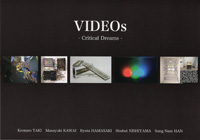 |
 |
| Videos: Critical Dreams |
| 22 August - 20 September 2015 |
Mori Yu Gallery Kyoto
(Kyoto) |
 |
| In this group show addressing the materiality of video as a medium, Masayuki Kawai connected secondhand analog video equipment with multiple cables, generating psychedelic, abstract patterns on a central monitor. Shuhei Nishiyama separated audio from video and further reduced his images to flashing primary-color lights or binary light-or-dark rectangles. By forcing upon us an awareness of the video medium itself, these artists question what it means to "see" through these electronic devices. |
|
|
|
|
 |
|